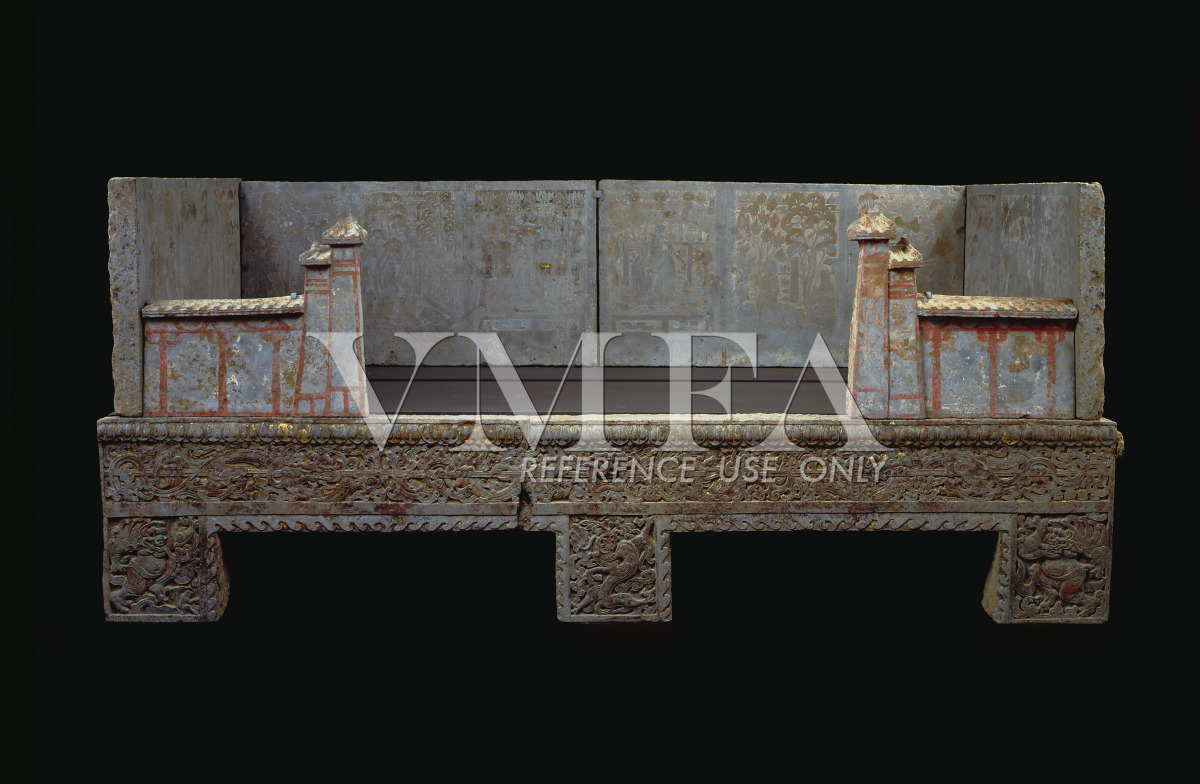
Funerary Couch with Images of Filial Piety (Translation)
孝子畫像圍屏石棺床 北魏 (Primary Title)
Unknown (Artist)
Imitating wooden household furniture, this stone couch is a rare example of a funerary platform used in the burial chamber of a tomb. The front panels feature two gate towers and a wall leading through the entranceway to private property. Details include molded roof tiles and painted designs of wooden frames and brackets representing early Chinese architectural components. The iconographic scenes engraved on the back and side panels illustrate the life of the owner of this couch, ranging from the portraiture of the seated couple to ritual processions and landscape designs. Also engraved are classic stories of filial piety, a reverence for one’s parents and elders and a central value of society in traditional Chinese culture, which became increasingly popular with the development of Confucius’s teachings in the early 6th century. Carved on the baseboard are mythological animals, such as a dragon and the Wind and Thunder Spirits amid floral scrolls, integrating both Chinese and Central Asian elements.
Both the form and function of this couch reflect ancient Chinese beliefs in the afterlife and the search for immortality. Although the owner and origin of the couch are unclear, its stone structure and pictorial style indicate that it most likely belonged to a local official from Central Region of China.
The stone couch contains the following twelve scenes that illustrate six filial stories:
1. Procession of female attendants
2. Oxcart for female tomb occupant
3. Story of Guo Ju 郭鉅為母埋兒
Guo Ju lived in poverty, but he continued to take care of his elderly mother at home even after he married. Unable to feed the entire family, Guo decided to bury his own son alive in an act of devotion to his mother. This scene depicts Guo Ju, his wife, and son as they walk into the woods to dig a grave. Miraculously, a jar of gold appears as a heavenly reward to Guo Ju for his filial piety.
4. Story of Yuan Gu 原穀持祖還舍
Yuan Gu lived with his father and grandfather. One day, his father took the grandfather away in a carriage and abandoned him in a forest. A tearful Yuan Gu shamed his father by retrieving the carriage and warning “when you get old and sick, I won’t need to make a new carriage.” The scene depicts Yuan Gu and his father carrying his grandfather back home through the woods.
5. Story of Wang Xiang 王祥捕雀事親
When Wang Xiang was young, his mother passed away and his father remarried. A devoted son, Wang Xiang honored his stepmother’s unreasonable request for fresh-cooked sparrows. This scene depicts the young man serving birds that were sent to him miraculously after days of his futile efforts to catch them himself. The man standing behind him foreshadows his fate: Wang Xiang would later be appointed a high-ranking military officer as a reward for his devotion to his parents.
6. Female tomb occupant
7. Male tomb occupant
8.
Story of Dong Yong 董永鋤田事父
Dong
Yong was a poor, young farmer who lived in Qingzhou, Shandong Province. When
his mother passed away, his elderly father was left alone at home. Dong Yong
decided to take his father to work to ensure he lived in comfort during the
day. This panel illustrates Dong Yong working in the fields with a hoe while
his father sits nearby in a cart under the shade of trees, enjoying food and
drink.
9. Story of Ding Lan 丁蘭刻木事母
After his mother’s death, Ding Lan made a life-size wooden figure of her and placed it in an altar shrine for daily worship. In this diagonal composition, Ding Lan kneels down, praying in front of the statue, while his wife and son are offering food. A masculine winged creature flying through the sky represents the Wind Spirit, a legendary guardian who wards off evil spirits and offers the blessing of good fortune.
10. Story of Cai Shun 蔡順見火不惧
This panel depicts Cai Shun bending over his mother’s coffin, refusing to leave even though both the shrine’s roof and a nearby building are ablaze. Neighbors run frantically about, carrying water to put out the fire. The composition shows overlapping trees, layered mountains in the distance, and stylized clouds. The use of shallow and tilted space is characteristic of the 6th-century pictorial style.
11. Horse with a saddle for male tomb occupant
12. Procession of male attendants
Some object records are not complete and do not reflect VMFA's full and current knowledge. VMFA makes routine updates as records are reviewed and enhanced.

